Driver’s view: Charlie Flindt’s John Deere 6155M tractor
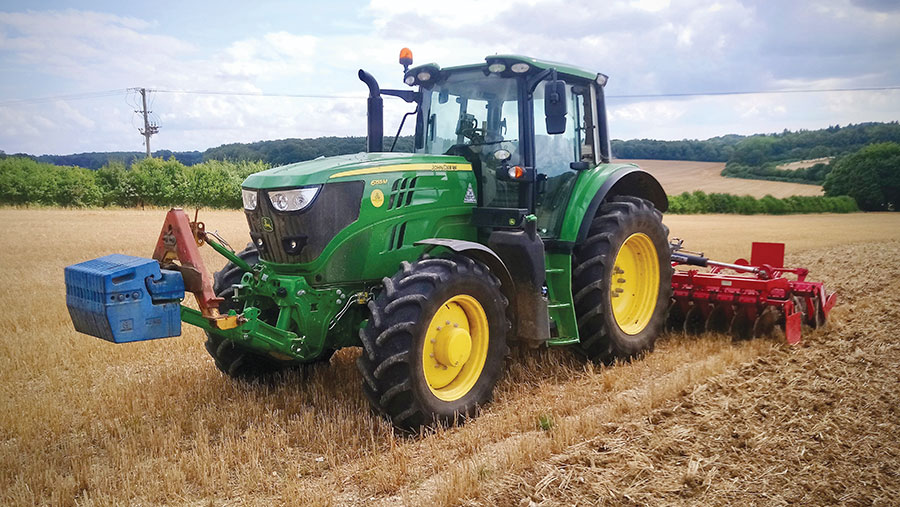 © Charlie Flindt
© Charlie Flindt Hampshire farmer and FW columnist Charlie Flindt gives us the 410-hour lowdown on his John Deere 6155M tractor in his inimitable style.
Find out what his likes and gripes are, how he rates the machine overall, and if “button goulash” is a new but inedible recipe.
See also: Video: John Deere 6155R Autopowr on test
This farm finally switched to John Deere in 2012. Dad had an enormous fall-out with a local dealer way back in the past, and was quite clear about them: “Deere? Here? Over my dead body!”
Once he was safely in Hinton Ampner churchyard in late 2011, I could go shopping.
My list of must-haves in a tractor was quite specific: three steps with a shallow slope, old-fashioned gearbox with powershift in each gear, opening side windows, cab suspension and manual spools.
And it had to pull the Horsch CO3 drill that I’d also just bought.
The 6630 Premium fitted the bill, and did nine almost faultless years, save some exhaust gas recirculation issues.
I chipped it when the Sprinter ST4 arrived, and it still didn’t miss a beat.
Changing it seemed a tad extravagant, especially as it had only just reached 4,000 hours, and finding a direct replacement seemed unlikely.
Hunt’s of Chilbolton suggested that a day or two in a demo 6155M would prove that, to all intents and purposes, it would be a case of “same again, please”, and they were right.
It was delivered, after a respectable mid-lockdown delay of only six months, in October 2021.
John Deere 6155M spec
- Engine 6.8-litre six-cylinder John Deere PowerTech
- Max power 172hp
- Max torque 726Nm@1,600rpm
- Transmission 20/20 40kph
- Lift capacity 7,765kg (rear), 4,000kg (front)
- Price £125,077 (pre trade-in and discount, April 2021)
First impressions
At first glance, the 6155M was pretty well a carbon copy, with what looked like the same cab (apart from some lighting changes and cosmetic tweaks) and an almost identical backend.
The bonnet was, of course, different, and overall dimensions were larger.
I’d specified 460/85 R38 and 420/70 R28 tyres (my “year-round” choice – the days of wrestling with row crops are well gone), and they looked a bit small in the wheel arches.
But they did succeed in minimising the Deere’s overall height – and the climb into the cab.
As a result, machine transfer issues were minimal and both Horsch drills went straight on, as did the FarmGem trailer sprayer.
The front linkage is plumbed in a bit more tidily, with shut-off taps nice and accessible next to the front wheels.
The push-out pick-up hitch is far better organised too, with a rocker switch in the cab replacing external hydraulic pipes.
Another bonus of the near-identical cab design is that the pricey plastic window protectors for hedgetrimming fitted perfectly.
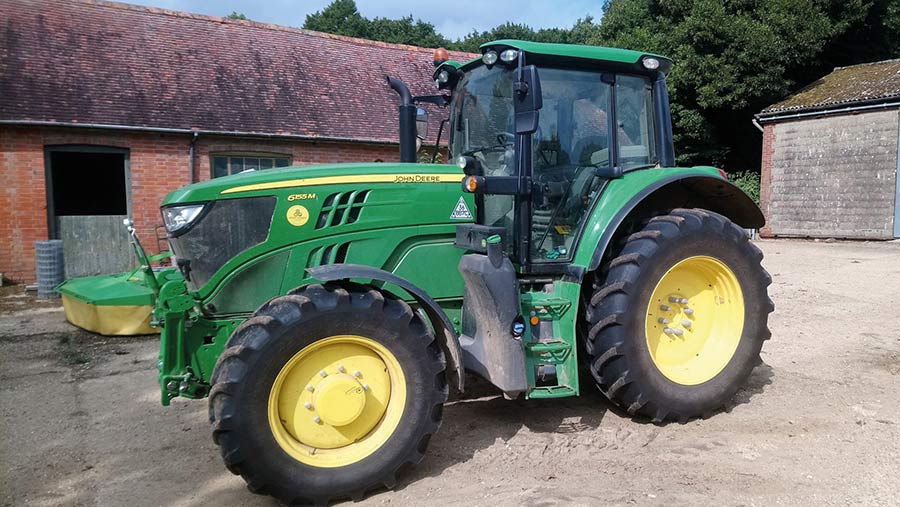
© Charlie Flindt
Inside, it’s a bit of curate’s egg. The spool valves and gearstick are much the same, although the gearbox is a basic 40kph 20/20 rather than 24/24.
I’ve yet to notice any practical difference, but pulling away in “fifth” isn’t as easy as it was.
The spools are still angled awkwardly and aren’t best placed for the massed ranks of buttons – but more on them later.
Sensible round dials have been replaced with a digital display on the A-pillar, for absolutely no gain; you just get a view forward of more bonnet and the world’s daftest phone slot.
The radio and heating controls, previously nicely in line of sight, have also vanished from the cab roof.
The radio is now at an awkward “over the right shoulder” site (terrible when you need an urgent station change – every time Ellie Goulding comes on, for instance.)
The heater controls have vanished into the absurd bank of buttons that lurk under the side window.
Deere says it has been “guided by best-practice ergonomic principles” – which is one of the best “black is white” claims I’ve ever read in a tractor brochure, second only to “AdBlue will save you money”.
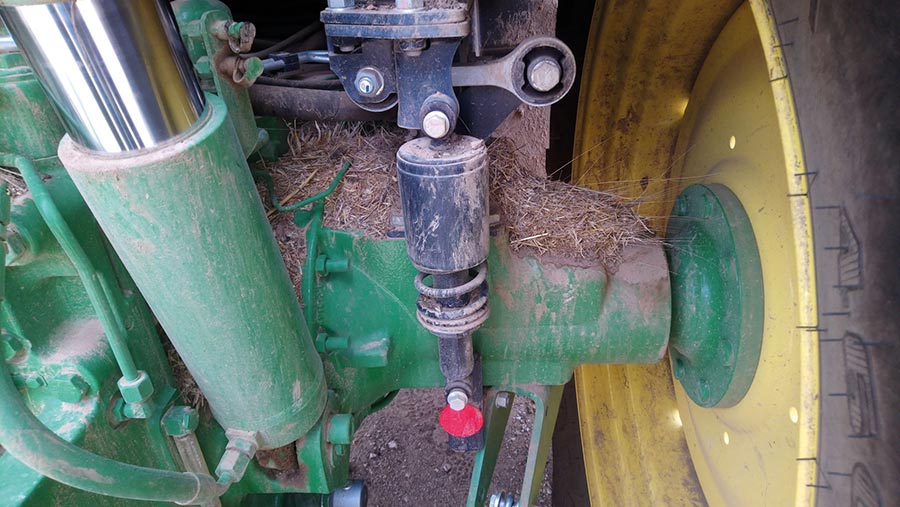
Mechanical cab suspension is simple but not particularly forgiving © Charlie Flindt
Piling as many functions as possible into one hard-to-find place and using teeny tiny buttons with teeny tiny symbols goes against everything I was taught about ergonomics.
While installing my vast selection of implement control boxes was easy (thanks to identical cab pillar mounting points), the spaghetti of cables does nothing to improve access to all the little buttons.
And, as is traditional in those Deere cabs, beware of dropping something behind the seat. You’ll never see it again.
Better points in the cab include both front and rear wipers which, for once, clear practical areas of the screen, an all-singing, all-dancing seat, and a key that slots into the traditional place.
The “farm office” briefcase turns out to be one of the most useful features I’ve ever had, too.
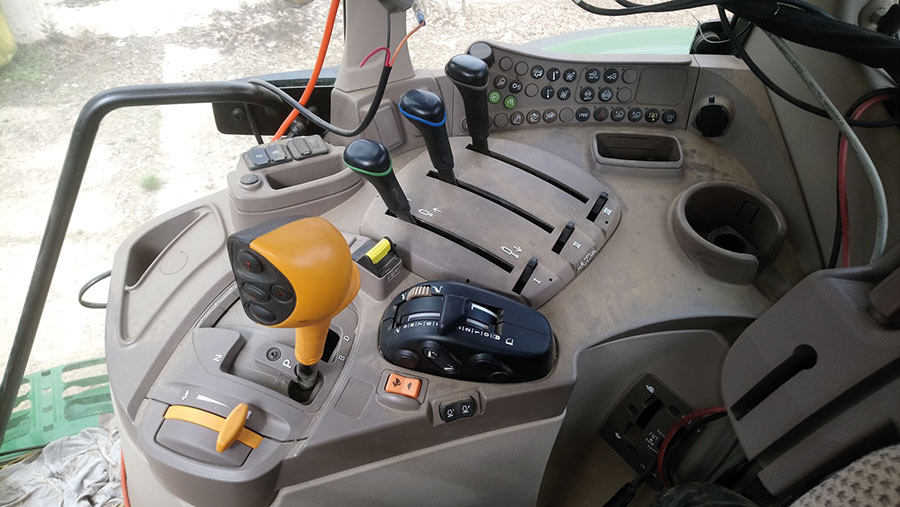
Manual spools were a must-have – along with opening side windows © Charlie Flindt
In work
I’ve yet to give the 155M a job that really tests it.
It handles the 4m ST4 drill and five-furrow Kverneland plough without any thought at all, and if it does start to roar, it’s usually the radiator fan kicking in – a cue to give the highly efficient radiator screens a good blast-off.
Most of the time, it runs quietly, with a very satisfying straight-six purr.
It has the same curiously oversensitive draft control settings as the 6630P. You need only the smallest shift from “position” to “draft” when ploughing; any more than that and the Kverneland leaps about on the rear linkage frenetically.
Luckily, the vast majority of the 155M’s tasks are lower-link connected in a fixed position.
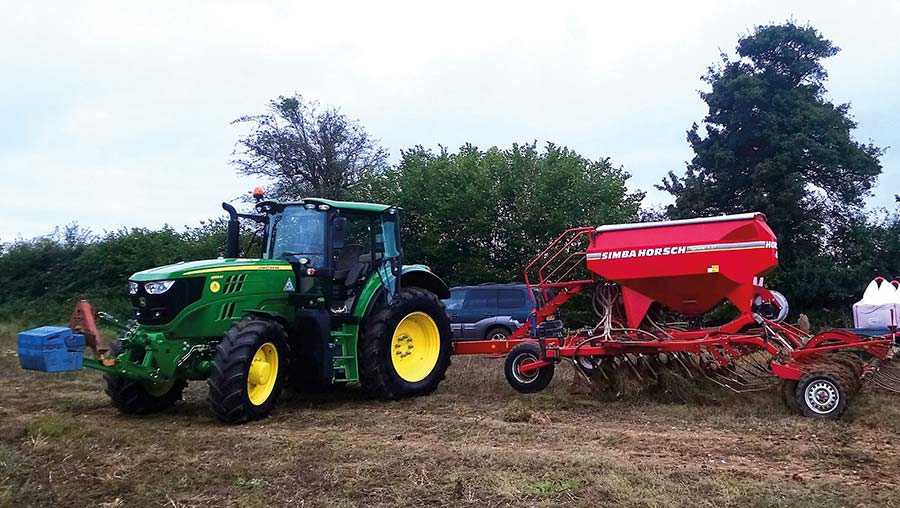
It has no problem pulling the farm’s Horsch drill and five-furrow KV plough © Charlie Flindt
Cab suspension is mechanical, rather than the sophisticated hydraulic setup on the 6630P, and it shows.
Doing one more tank of spray at 7.30pm isn’t as welcome an idea as it was, although it’s still miles ahead of no suspension at all.
Reliability and costs
There’s been only one issue so far – the manual pto speed selector struggles to get the cogs engaged, and it’s not in the easiest position for a wrestle.
That’s a job for the first annual service. I’m not a pedantic measurer of diesel, but the impression is that it seems thirstier than the old 6630P, and then there’s the AdBlue to be taken into account.
I’m also worried about the front tyres, which seem to have worn more in one year than those on the 6630P did in nine.
It might be too much power going through narrow tread, or that they’re on the very limit of sensible “lead”.
The 100-hour service came in at £522, but Hunt Forest says there’s no need for an annual service; they’re happy to wait for it to get to 750 hours.
Like and gripes
✅ Simplicity
✅ Plenty of power
✅ Side windows
❌ Button goulash
❌ Oversensitive draft control
❌ A-pillar infocentre
Charlie’s verdict
In many ways, a solid old-school tractor, pleasingly low on sophistication, but occasionally even lower on ergonomics.
It feels a bit less refined that its predecessor on the farm, but that’s only to be expected.
Anyone who drove, say, a Ford 7810 30 years ago will be able to jump in the Deere, start it and drive it. I bet even Dad would have managed it – and approved.


